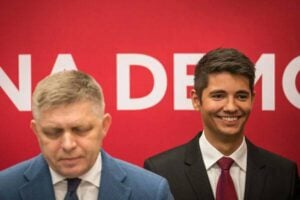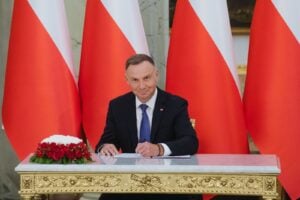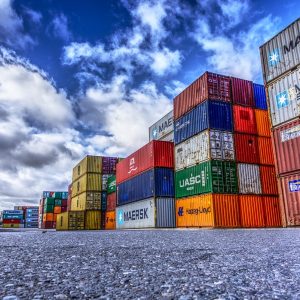St. Sophia Cathedral is still on the list of potential targets of the Russian army – Kukovalska
9 May 14:37 INTERVIEW
INTERVIEW
Moscow wants to strike at St. Sophia Cathedral. The shrine remains on the list of potential targets of the Russian army. In a long interview, Nelya Kukovalska, Director General of the St. Sophia of Kyiv Reserve, talks about the threats of an attack and her fears about Oreshnyk. How the Kremlin is trying to erase our memory, stealing Ukrainian relics, and even trying to buy the relics of Yaroslav the Wise, which are now in the United States. Also, read about the diplomatic battles for the return of the icon of Mykola Mokryi in Kommersant Ukrayinsky‘s article.
Russia’s missile terror continues. Back in November 2022, you said that you had been warned about a possible missile attack on St. Sophia of Kyiv. Does this risk remain relevant today, in the fourth year of a full-scale war? Have there been any secret negotiations about the inviolability of the cultural monument?
Russians want to destroy St. Sophia of Kyiv
Yes, at the beginning of the war, we had very serious warnings from Ukrainian foreign intelligence that the Russians were aiming to destroy St. Sophia of Kyiv. We then did a lot of work together with the staff and the Ministry of Culture to protect the shrine as best we could. But I do not exclude that it is still on their list of targets. And the recent information about a Russian Oreshnyk missile targeting Kyiv only heightens my concerns. It is important for them to destroy our identity. And St. Sophia is not just a church, it is our language, our faith, our culture, our heritage. These are the identifiers of the Ukrainian nation. If they are destroyed, Ukraine will be destroyed.
Every missile strike on Kyiv is a wound in my heart. I’m probably less worried about anything else than I am about Sofia.
And what would the destruction of St. Sophia mean for Russia, since it is a UNESCO World Heritage Site?
They have already attributed St. Sophia to their history. But the more we popularize the true Ukrainian history, the more difficult it is for them to do so. During the years of war, I visited many countries in Europe and America, telling them about our history and about St. Sophia. And I am sure that most of the world already understands that St. Sophia of Kyiv is a symbol of the Ukrainian nation. It has nothing to do with Moscow’s history. It hurts them. And they want to destroy it because they could not appropriate it.
So when missiles are flying at Kyiv, I feel a terrible danger. I intuitively feel it and sincerely believe in our air defense.
Читайте нас у Telegram: головні новини коротко
How did the relics of Yaroslav the Wise end up in New York?
You mentioned that you traveled a lot. In particular, it is known that the relics of Yaroslav the Wise are probably kept in the United States. Do you have any information on where they are: in someone’s private collection, museum, or research institute?
It all started in 2009. We were preparing a scientifically unified passport for a museum object, a sarcophagus, which, according to documents, contained the remains of Yaroslav the Wise and his wife, the Swedish Princess Ingegerd. In order to issue a passport for it, we had to open it and examine it. The sarcophagus was first opened in 1936 and 1939. And then it was confirmed that one of the skeletons belonged to Yaroslav the Wise. This was determined by anthropology – the signs matched the chronicle descriptions.
In 2009, we hoped to use modern technologies to study DNA, determine the genus, age of death, diseases, and even recreate the appearance. It was an interesting interdisciplinary research project involving anthropologists, doctors, and pathologists. But when we opened the sarcophagus, there were no relics. It was a shock. I led the search.
What versions did you consider? Where did you start looking?
There was one important thread. We came across an article by Serhiy Bilokon, a doctor of historical sciences, who was on an internship in New York in the 1990s and came across an icon of Mykola Mokryi. This led us to the Ukrainian Autocephalous Orthodox Church in South Bound Brook. By order of the Cabinet of Ministers, I went to the United States.
I met with Metropolitan Anthony. In a private conversation, he told me: “Ms. Nelly, do not look for Yaroslav. He is with us.” It was like an explosion in my heart. We knew that they had the icon of Mykola Mokryi. But now there is hope that Yaroslav’s relics are there as well.
Were you able to confirm this officially?
No, unfortunately. The next meeting was to take place not with Metropolitan Anthony, but with a representative from Chicago, Metropolitan Daniel. But after their internal conversation, the door closed. The topic was closed. I repeatedly tried to return to the dialog in vain. However, I spoke with migrants, in particular with Mykola Herets, the elder of the Holy Trinity Church, where the icon is kept. He confirmed that both the relics and the icon were moved to the dungeon of the church, which used to be a bank, when the church moved from Manhattan. We were invited to this church, and we walked across the Brooklyn Bridge, carrying the icon of St. Nicholas the Wet and the relics of St. Yaroslav the Wise. It was a revelation for me. I saw the icon and tried to get it examined, but not everything depended on me. Unfortunately, some officials did not listen to me.
What is this icon of Mykola Mokryi? What is its historical and cultural value?
This is a miraculous icon. According to recent research, it could have been brought by Anna Porphyrogenitza, a Byzantine princess who became the wife of Prince Volodymyr. That is, we are talking about the tenth century. It is most likely from St. Sophia of Kyiv. She has been mentioned since the 14th century, and perhaps even earlier. Bolkhovitinov described its miracles as early as 1825.
The icon must be returned. I told President Yushchenko about this as well. But under Yanukovych, such issues were not raised because they began to promote the idea of the “Russian world.” And we are even anthropologically different from Russians – I read this in the works of anthropologist Novikov at the institute.
President Zelensky also raised this issue. And in 2023, in his address, he said that the United States had promised to return the icon of Mykola Mokryi. For me, it was a holiday. But so far, the promise has not been realized.
To return what was stolen by Russia
We are talking about sacred relics that are of great importance to our national identity. Do you have any data on how much cultural property Russia has taken out of Ukraine during this war or in previous centuries? How much did Russia steal on purpose?
Of course, there are many such examples. We remember that before the Second World War, St. Michael’s Golden-Domed Cathedral was destroyed. At that time, all the most valuable mosaics, including the mosaics of the 12th century, masterpieces of monumental art, were saved. The most valuable frescoes were removed from the walls and transferred to St. Sophia of Kyiv. To this day, if you go up to the second floor of St. Sophia, there is a whole hall that we call St. Michael’s Hall, where these mosaics and frescoes are kept.
But in 1939, a large exhibition opened in Russia, and the best exhibits from St. Michael’s Cathedral were taken there. In particular, the figure of St. Dmitry of Thessalonica, one of the best examples of monumental art of the twelfth century. It has not been returned to this day, despite all the appeals of the Ukrainian state. This icon is now kept in the Tretyakov Gallery.
In addition, Russians continue to take masterpieces from St. Michael’s Golden-Domed Cathedral to international exhibitions dedicated to Byzantium and present them as “Russian art.” But “Russian art” has nothing to do with these world-class masterpieces.
Recently, the museums of the Moscow Kremlin published an electronic catalog of items from their collections. Our scientists saw it on the Internet and were able to identify 56 items from the treasury of St. Sophia Cathedral. These are chalices, altar crosses, vestments, vestments – unique examples of applied art that were kept in St. Sophia before the revolution.
This was after the outbreak of a full-scale war. After our victory, this issue must be raised as a matter of restitution. It needs to be raised at all levels.
It’s a shame that the committee for the return of cultural property was liquidated during Yanukovych’s time. It needs to be restored, and the return of museum objects, both those that were exported earlier and those stolen during the annexation of Crimea and the occupation of other territories, should become not only a matter for Ukraine, but also an issue for the entire civilized world.
Читайте нас у Telegram: головні новини коротко









